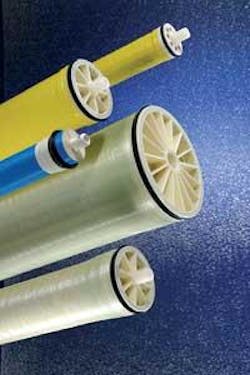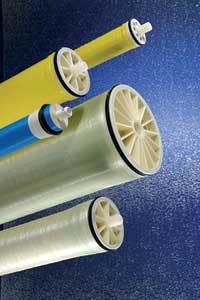Avoiding Testing Errors: Protecting RO Membranes from Chlorine Damage
by Cliff Gilbert
Chlorine (Cl2) has long been an essential component in municipal, industrial and wastewater treatment due to its ability to eliminate most pathogenic microorganisms. However in reverse osmosis (RO) systems, membranes are easily damaged by chlorine in the feed water.
Chlorine damage to the membrane can lead to lower salt rejection and poor-quality permeate, which in turn could result in costly membrane replacement and down-time.
If chlorine is present in the feed water, it is common practice to neutralize it with a sodium sulfite solution, a carbon bed, or combination of the two. Either technique works well, but sometimes operators who use these technologies and monitor their chlorine levels are surprised when they discover that their RO membranes are still damaged by chlorine.
Some of the reasons chlorine slips past the dechlorination systems include inactivated bisulfite solutions, old carbon beds, pump failures and human inattention. But one possibility that is frequently overlooked is that the chlorine test itself is wrong. The common chlorine test is the DPD [N, DPD (N, N-diethyl-p-phenylenediamine)] test. A brief look at some of the various ways that the testing can go wrong will help operators when troubleshooting the RO system.
Chlorine Damage
To prevent oxidation on thin-film RO membranes, the feed water must be dechlorinated. Most membranes will have some chlorine tolerance before there is an observable decrease in salt rejection. Chlorine on the membrane can be discovered by an initial loss of membrane flux followed by an increase in membrane flux and salt passage.
For Dow FilmtecTM RO membranes, degradation can occur after roughly 200-1,000 hours of exposure to 1 mg/L of free chlorine. Unfortunately, chlorine damage is irreversible with any RO membrane, so proper steps must be taken to prevent it.
One drawback to the dechlorination process is that it can lead to biofouling on the RO membrane. For years, the standard operating procedure has been continuous chlorination and dechlorination of the feed water. Still, occurrences of biofouling after dechlorination are common. When chlorine reacts with organic matter in the water, it breaks it down into more biodegradable fragments. Unless the system is sanitized often, microorganisms can grow freely after dechlorination, since there is an enhanced nutrient offering but no chlorine on the membranes to act as a preventative.
Other dechlorination methods are growing in practice, such as applying chlorine off-line to the pretreatment section. All require careful monitoring and operating to prevent microorganisms from fouling the membrane.
Chlorine Testing Pitfalls
Routine testing for chlorine is essential for operators and has become more convenient in recent years. The most common test for chlorine uses premeasured reagent “pillows,” which contain a mixture of DPD and some buffers. If chlorine is in the water it will react with the DPD and produce two compounds: a pink-colored Würster dye and a colorless imine. The concentration of the chlorine is determined quickly by measuring the absorbance of the DPD-Würster compound at 530 nanometers in a small spectrophotometer or color comparator. Though the test kits are simple and straightforward, several mistakes can happen during the test.
Improper sample preparation
The DPD test is designed to be performed in the pH range of 6 to 7. If the pH of the feed water is outside of this range, the pH of the sample must be adjusted before running the chlorine test. If the pH is not adjusted, then it is possible the color will not develop and the test will wrongly indicate “zero chlorine.”
One industrial client found this out the hard way. Their daily DPD tests indicated that the chlorine level into their RO was “zero.” However, despite the apparent absence of chlorine, the new set of membranes they installed degraded in less than a month. Investigation showed that the bisulfite solution used for chlorine reduction was over three months old and had converted to sulfuric acid. The addition of this acidic bisulfite depressed the pH of the feed water. The pH ranged from pH 3 to 6, but was on average closer to pH 5. When the chlorine test was run at the proper pH, it indicated that chlorine was in the water.
It is not uncommon to see the feed water pH to a reverse osmosis system out of the DPD test range. For example, in the first half of 2008, the pH of the municipal water in the Boston, MA, region ranged between pH 9.3 and pH 9.7, almost 3 pH units outside of the test range.
If the water coming into a facility is not out of the test's pH range, often the RO pretreatment will change it. For example, some RO operators add acid to the water to lower the risk of calcium carbonate scaling, while yet others raise the pH to lower carbon dioxide passage through the RO membrane. In either case, it may be necessary to adjust the pH of the water sample before running a chlorine test.
Concentration Range
Another misreading of chlorine levels can occur if the water being tested is out of the particular test kit's detection range. The DPD chlorine test has a detection limit that typically ranges between 0.02-2.00 ppm and 0.1-10 ppm. If one is testing water containing 4 ppm chlorine with the 2 ppm test kit, the DPD will be oxidized by the excess chlorine to the colourless imine and not the desired colored Würster dye. In this situation, the test solution would again indicate that there is no chlorine in the water.
Hoarding
Though it may sound like common sense, it's imperative to use test kits that have not passed the expiration date. A common sight in many industrial labs is a cabinet full of pH calibration solutions and a lab drawer (or two) full of DPD chlorine-test pillows. In both cases, the packaging is unopened and looks new and ready to be used. A closer look at the labels on these chemicals often reveals that the pH solutions and the DPD pillows are two to five years past their expiry date. Put simply, if the chemicals are old, one cannot count on the test results. There is only one thing to do in this situation: dispose of these old chemicals and buy a fresh supply.
Other interferences
The DPD and other chlorine tests can be interfered with by a number of chemicals not discussed here. These include manganese, ozone and chloramines. Be sure to review the literature that comes with your test equipment as it will describe these interferences and how to manage them.
Follow the rules for accurate results
Chlorine testing is an important part of maintaining a well-running reverse osmosis system. Chlorine monitoring helps protect reverse osmosis membranes from unwanted oxidation. The manufacturers of chlorine test kits have simplified the chlorine test procedure and made the test very reliable. However, the reliability of the test and the safety of the RO membranes depend on the test being performed with fresh reagents and at the conditions specified by the manufacturer.
For more information on cleaning and protecting RO membranes, go to http://www.dow.com/liquidseps/service/lm_clean.htm. —m
About the Author:
Cliff Gilbert is a senior account manager with Dow Water Solutions. He has worked for the Dow Chemical Company since 1984 in a variety of roles in manufacturing, sales and marketing. He holds a bachelor of science degree in Chemical Engineering from the University of Toronto, and can be reached at 856.231.8392, or [email protected].

